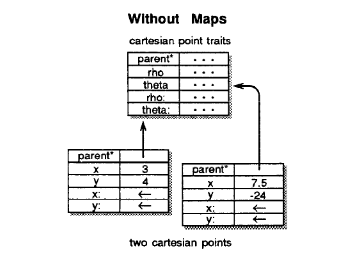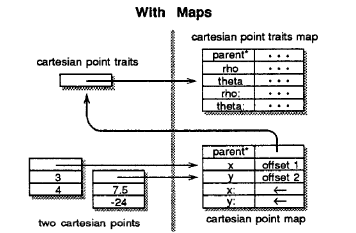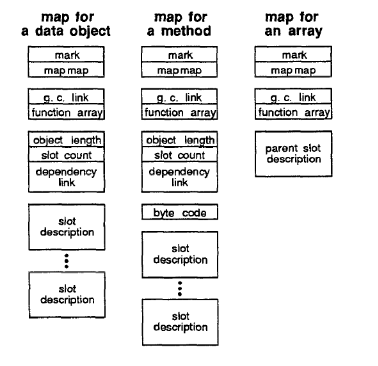Efficient SELF Implementation

Background
TLDR
This paper is on an efficient implementation of the Self programming language. They detail the reasons which make Self difficult to compile, and present a JIT (just in time) compilation strategy for Self, getting over twice as fast as Smalltalk, which is a comparable language, much more popular at the time.
Language description
So what is Self, and why is it so hard to write a compiler for? Well, Self is just about as dynamic of a language as you can get. It is object oriented using a prototyping model instead of a class hierarchy, and everything is done through message passing, which is also inherently very dynamic.
Self objects
Self objects are a collection of “slots”, which can contain a variety of things. In general, they either are method slots, data slots, or parent slots. Method slots are exactly what they sound: they have Self code which describes some kind of method on the object, which can be invoked by passing a message. Data slots contain either primitives or Self objects. Mutable data gets two slots: one for the data and one for the “assignment” operator, which is again invoked by a message pass. Parent slots provide the true power of Self: inheritance. Self supports dynamic and multiple inheritance: you may have as many parent slots as you like, and may change them at runtime.
Message passing
As mentioned above, everything is done through message passing: it is the only control flow structure. The way message passing works, is that messages are passed to a receiver. Then, the receiver’s slots are searched for a slot with a name that matches the message. If none are found, the parents are searched recursively until a matching slot is found. Once a slot is matched, it’s contents are evaluated and returned. A data slot would just return it’s value, whereas a method slot would have to run some Self code, potentially with arguments provided in the message.
Example
Let’s look at an example from the paper:

Here is an object hierarchy for Cartesian and polar points, that allows
conversion between. If we want to get the x coordinate of a Cartesian point,
we send an x message, and Self will find the matching slot, and return 3 in
this case. Now imagine we send the x message to the polar point shown. There
is no slot named x so the parent slots are traversed. The x slot in polar
point traits is found, and evaluated. This results in more message passing,
looking up rho and theta, and also a cos slot which works on floats, and
multiplication. Finally, this will evaluate to 1.25 which is then returned. We
can see how this means that all points regardless of representation will be
printed as Cartesian, as the print method uses the x and y methods. Also,
the + slot which allows adding points will all work in Cartesian space, so if
you add two polar points, you will get a Cartesian one.
Some other object features are object arrays and byte arrays. Object arrays are exactly what they sound like, and byte arrays allow for a more compressed data representation, which is helpful for strings.
Implementation
Object storage system
At a glance you may see a problem with the prototyping model that has no classes: a lot of data will be duplicated across objects. If we think about the point example above, there is some inherently shared structure between a bunch of Cartesian points: in this case, the parent and the assignment slot. This is why the paper introduces maps, which are a memory layout that if you squint, looks like it mimics a more class based system.
Here are a couple points in memory without maps:

And here once maps are used:

As we can see, most slots can be factored out into a common map, with the exception of the assignable ones. These of course need to be unique to the individual object, but it is possible to factor out the structure by putting the memory offset into the map. Maps serve two purposes: they let Self recoup the lost memory performance over a class based model, and they provide more information to the compiler about what can be optimized, but more on that later.
Object formatting
Self is a garbage collected language, so there needs to be some metadata around for the collector to use. One annoyance surrounding this is byte arrays: they really can look like anything, and they are NEVER pointers. The authors provide a novel solution to this: store them in a separate section of memory that is never traversed by the garbage collector. After reading this, it seems like an obvious solution, but it is quite elegant.
Tagging
Outside of byte arrays, all data needs to be tagged. The tagging format is detailed in the following diagram:

The two least significant bits are the tag bits, and Self is designed to run on a 32 bit machine. Integers are tagged with 0 so that arithmetic instructions don’t have to do any special work, and virtual machine addresses use the same tag. The reason for this is that the integer tag tells the GC never to relocate these, and it isn’t going to be relocating VM addresses either.
Self heap objects also get their own tags, as these are the ones that the GC
will deal with. Floats need to be tagged differently than integers, as Self
supports operators like + and < which are polymorphic on numeric types, and
use different machine instructions.
There is one more tag available, and it is used for the mark header word, which is the beginning of a Self object, and contains some metadata for the GC as well as some immutable bits that are used by the hashing primitive.
The actual objects
Every Self object begins with a mark header word, as mentioned above. Then, there is a pointer to the associated map, and after that there are some slight differences between object types. Normal objects have a sequence of slot contents for mutable slots. Object arrays then have the length, followed by the literal elements (pointers if objects). Byte arrays are similar, but the contents are padded out to 32 bit word boundaries.
Map layout

Maps also have a slightly varying layout depending on the type. All maps share the same map, which is referred to as the “map map.” They also need to have a GC link so that the GC can traverse all of the maps.
Bytecode
This is relatively uninteresting, but should be mentioned. Self code is compiled to a bytecode that is at the same time very simple, and also expressive. It is almost just a syntax rewrite of the message passing with everything being on a stack, so this translation phase has a lot more to do with ease of interpreting and simplicity of the representation than some earth shattering transformation.
How it goes fast
The real interesting part of this paper is how it makes Self go so fast. Previous work on making Smalltalk quicker was mostly focused on adding static types that the compiler can take advantage of, but this defeats the purpose of having such a dynamic language, so the authors employ a JIT with surprisingly few optimizations.
Customized compilation
The first optimization presented in this paper is “customized compilation,” where when a method is run with a certain type of receiver, this is noted and compiled for that specific type, where other message sends can be disambiguated at compile time. This is a huge advantage since a lot of the overhead in dynamically typed languages like this comes from having to constantly check the types of everything to determine which code to run, but in this case once you do something multiple times with the same types, you will have fast, specialized machine code to run.
Message inlining
Sometimes messages lookups can be resolved at compile time1, and in this case they are inlined. Methods are inlined as code if they are short enough and non-recursive. Constant data can have its value inlined, whereas mutable reads and writes can be inlined as a single machine instruction (either load or store), since the offset is known. This is where the maps come in handy for giving the compiler information that is easy to work with.
Message splitting
A lot of the efficiency of this implementation comes from this specialized
compilation that allows message inlining, but this nice type information is lost
at CFG merge points, as you may have two specializations that merge together and
then share code. The idea of message splitting is to push those merge points
later, and then optimize the resulting code that has more type information,
resulting in more specialized code. The reason we get more type information is
that say you have two branches of an if statement where on one x has type A
and on the other type B. Then, after the merge point you don’t know whether
x is an A or a B, but if you push the merge point down, you can specialize
the code for each type. This may seem in general compilers not to be
a great idea, as there would be too much of an icache penalty, but in this case
the message inlining results in such drastic reductions in code size it is worth
it to give more opportunities.
Type prediction
Even when types are known for customized compilation, they might change as
everything is dynamic in Self, so the above customized compilation has an
element of optimism to it. Type prediction takes that optimism one step further,
and uses static heuristics to “guess” the types at compile time, and insert
specialized code. This allows the compiler to have very efficient code for
common cases like if/else without special casing them out. This also means
that users can define their own custom control flow like methods and get similar
performance: you aren’t beholden to use certain “built in” features.
The programming environment
Self has a very difficult to support programming environment. It is highly interactive, allowing users to incrementally recompile invalidate old code. Source level debugging is also a must, which means there needs to be a way to recover the original control flow after optimization.
Incremental recompilation
Support for incremental compilation mandates a mechanism for invalidating compiled code, as certain assumptions can drastically change on a recompile. This is where the aforementioned dependency link comes in. The links are for compiled methods, so they can reside in maps, and have links to the slots that it depends on. The information used to make assumptions to compile code is the format of objects and constant valued slots: precisely what is stored in maps, which is why dependency links don’t have to worry about individual objects.
The actual structure is a circular linked list which links a slot description or a map to all the dependent compiled methods. This allows the compiler to traverse this list and invalidate everything upon a change.
Debugging
Ideally, it is possible to step through source programs in a debugger, without having to reason about internal representations of the compiler/runtime. This is complicated by the aggressive inlining performed by the Self compiler, so it takes some trickery. This trickery is accomplished by looking at each “scope” compiled (basically a method after inlining) with information about all of the inlined methods, which allows a reconstruction of the virtual call stack which has been optimized away.
Breakpoints are another problem after specialization, as a bidirectional mapping between program counter and byte code instructions won’t be one to one nor will it even be a function. The way this is resolved is by having the debugger look up the latest PC address in the mapping which is before the current one, and the latest byte code that is mapped to this address. This gives the last byte code block which has started running but not yet completed for any PC, which can find the bottommost virtual stack frame for a given virtual one.
Performance
Basically, Self is faster than Smalltalk, but not as fast as C. No one expects Self to be as fast as C, but it comes surprisingly close (factor of 3-6 times slower). The most interesting part of the performance evaluation is comparing with the Hurricane Smalltalk compiler, which used type declarations to make compilation more optimal. The performance gains of this Self compiler were similar, which is a good suggestion that this project is successfully using type information collected at runtime, as it isn’t really doing any other optimizations.
Remember we are talking about a JIT here, so there is some run time information available at compile time!